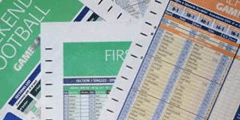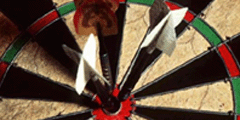With 47 different stats categories to choose from, picking your way through golf form is a minefield. Which stats tell you when to put your bling on Singh? James Collins brings you the rules to follow.
Ask ten golf tipsters how they come up with their weekly selections for European and American tournaments, and they will probably tell you the same formula. Firstly, there is the player’s current form. Then their previous form on the course. Then more personal aspects, such as news of injury or lurid divorce cases.
And then there are statistics. If there was ever a sport for which stats are an essential betting guide, it’s golf. The PGA Tour lists 47 different categories of number crunches. Most are as useless as a European at a US Open, but some are invaluable in the pursuit of winners. The key is to know which stats to study. In golf, not all stats are the same. So, as you are preparing to place your bet, you need to know just what to look for when you read golf form.
The most important statistic is a player’s Scoring Average. Not to be confused with a player’s Stroke Average (called Actual Scoring Average in the US), it’s listed on the PGA’s website (pgatour.com). The governing body of the US tour describes Scoring Average as: ‘A weighted average, which takes the stroke average of the field into account.
‘It’s computed by adding a player’s total strokes to an adjustment, and dividing by the total rounds played. The adjustment is computed by determining the stroke average of the field for each round played, subtracted from par to create an adjustment (per) round. A player accumulates these adjustments for each round he plays in.’
Flip side of the anomaly
All of which means it’s a far better assessment of a player’s performance because it takes into consideration how tough a golf course is. A player’s Stroke Average, by contrast, is his average hits per round. For example, up until the last tournament of August this year, Jesper Parnevik, Ted Purdy, Bart Bryant and John Senden all ranked in the top 25 on the Stroke Average stats, but didn’t feature in the top 25 Scoring Average list. In fact, between them they drop 60 places. The biggest factor in that drop – and the biggest guide to their real form – is the fact they played in just three Majors and only one World Golf Championship event between them.
The best example of the flip side of this anomaly is Sergio Garcia, who up to the end of August ranked 28th on the Stroke Average but ninth on the Scoring Average. ‘El Nino’ plays in few lower and middle ranking tournaments. Hence his ninth place on the Scoring Average gives a better indication of his performance level.
But how do you use this to your advantage? Odds compilers pairing golfers together for match bets sometimes take a snap judgment on the merits of certain players using the wrong figures. This is where you can find some value. It pays to check carefully how players have been assessed to see which Averages the compilers are using.
Putting stats are often misinterpreted, leading to poor player selection by bettors in tournaments requiring prowess with the flat stick. The US Open is usually thought to require players to putt well to win. A colleague told me this season that neither Ernie Els nor Garcia would get into contention at Shinnecock Hills – despite the fact that both had come into the US Open after victories. Both ranked outside the top 60 in the Putts per Round category at the previous week’s Buick Classic (which Garcia had won). However, they were both inside the top 20 of the Putting Average (or Putts per Greens in Regulation) stats. My colleague’s doubts were misplaced, as both players made the top 10 in the US Open.
So, Putting Average – which counts only putts taken on greens that are hit in regulation – better gauges a player’s putting ability. Why? Imagine if a player continually misses the green with his approach. He will be forever chipping from off the green towards the cup. It stands to reason that he will take fewer strokes with his putter because he will be closer to the hole when first using it. The Putting Average stat eliminates the effect of chipping close and one-putting a green.
Solid gold irons
Staying on the US Open theme reveals another area of stats ignorance. It is always said how tight the fairways are at Augusta, so many golf punters study the Driving Accuracy stats to look for a player who can drive the ball straight. Revealingly, however, only one of the past five US Open champions has been ranked in the top 50 in the Driving Accuracy category (using year end figures and through August for this season). All five champions, however, have commanded a top 25 spot in the Total Driving class (which takes into consideration both Driving Accuracy and Driving Distance categories).
Total Driving better reflects how straight a player drives from the tee, as the further you hit the ball, the more it deviates from a true line. While this means the shorter hitter should land the ball in play more often, it doesn’t necessarily mean he is straighter. For example, at the time of writing, Stephen Ames and Tom Pernice are ranked two spots apart on the Driving Accuracy stats. However, allowing for how far each player hits the ball, Ames is significantly straighter off the tee, as Pernice concedes nearly 25 yards on average per tournament, reflected in the naturalised Canadian’s ninth place at Shinnecock Hills to Pernice’s missed cut.
The Total Driving stat also unravels the argument that the Greens in Regulation category is the best way to form an opinion on how good a player is with his irons. Briny Baird ranked 99th for Total Driving up to the end of August, but fourth for GIR. Durant’s second place in both categories might mark him out as a better iron player, but Baird has passed more than 90 professionals who, according to the stats, are better drivers than him. Joe Durant, meanwhile, doesn’t improve. So it’s safe to say Baird is a better iron player than Durant, even though the GIR stats don’t suggest it.
You should also ignore Sand Save Percentage, which measures ability to finish a hole on par after being in a bunker. There isn’t enough data around to make this stat worthwhile. To boost my case, just take a look at Els’ ranking on the PGA Tour. Any instructor will tell you the South African is one of the best in the business from sand.
Lastly, be wary of carrying a set of stats from one tournament to another, particularly if two courses falling consecutively on a player’s schedule are radically different. If you want to know the strength of a tournament at a glance, look at how many world ranking points are on offer for that event. The more points, the stronger the field and the more worthwhile the form.
Stats & Info – And Where To Find Them Websites
pgatour.com/stats
Every drive, 7-iron and putt from the PGA Tour, collated in more than 40 categories.
europeantour.com/stats/data.sps
Eight groups of Reuters statistics on all of the European Tour players.
golfstats.com
Box scores, statistical guides and complete searchable records of American and European pros’ records on all Tour tournaments.
owgr.com
Latest world rankings, with tournament information and stats.
Annuals
Elliott’s Golf Form
The Golf bettor’s annual, with stats, records and punting advice covered in more than 900 pages.
Pro-Golf
The European Tour’s very own Media Guide, with complete player and tournament records.
PGA Tour Media Guide
The American Tour’s Media Guide, a hard copy of what is available on pgatour.com, with extended player, tournament and statistical details.
Magazines and Newspapers
Golf Weekly
All the very latest news from the European Tour and beyond, with updated stats and results.
Golfweek
American title that focuses on all American Tours, and features statistical updates from the respected Sagarin Index (which rates players’ performances).
Racing Post
Wednesday’s edition gives the latest prices for the week’s events with stats and tips. Tuesday’s paper runs a recap of the previous week’s tournaments.











